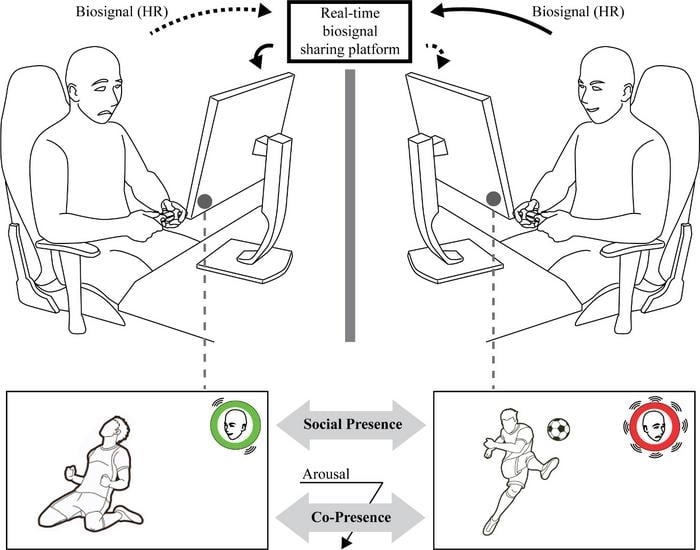Researchers at the University of Tsukuba have discovered that sharing biosignals like heart rate during online gaming can significantly boost the sense of social presence between strangers playing together.
Summary: A new study reveals that sharing real-time heart rate information during online gaming sessions can create a stronger sense of connection between players who have never met, approaching the social presence felt during in-person interactions.
Estimated reading time: 4 minutes
In an era where online communication tools are ubiquitous yet often fall short in providing fulfilling social interactions, a team of researchers has identified a novel method to bridge the gap. The study, published in IEEE Access, explores how sharing biosignals during online gaming can enhance the sense of social presence between players who are complete strangers to one another.
The research team implemented a real-time biosignal-sharing platform, which they called the “BioShare” system. This innovative approach allows players to view their opponent’s heart rate information during online gaming sessions, providing a unique window into their physiological state.
The BioShare Experiment
The study involved 20 participants who played a series of five soccer game matches, each time against a different opponent. To test the effectiveness of biosignal sharing, the researchers set up various conditions:
- Playing online without any information about the opponent
- Playing while viewing a live video of the opponent’s face
- Playing while viewing the heart rate information of the opponent
- Playing while viewing both a live video of the opponent’s face and heart rate information
- Playing offline in the same room with the opponent
The results were intriguing. Participants regularly glanced at their opponent’s heart rate information during matches, much like how they would look at an opponent’s face when it was displayed. This effect was amplified when both live video and heart rate information were presented together.
Measuring Social Presence
To quantify the impact of biosignal sharing, the researchers administered questionnaires designed to measure the level of perceived social presence. While the augmentation method couldn’t fully replicate the social presence experienced when playing together in the same room, the combination of bio-information and face video came closest to this optimal condition.
These findings suggest that sharing biosignals could be a powerful tool in enhancing online interactions, making them more meaningful and fulfilling. In a world where remote communication is increasingly common, this research presents a method for augmenting online interactions to create a stronger sense of connection.
Implications and Future Applications
The potential applications of this technology extend beyond gaming. As online meetings and remote work become more prevalent, integrating biosignal sharing could revolutionize how we connect in virtual spaces. It could help create more engaging and emotionally resonant online experiences, bridging the gap between digital and in-person interactions.
However, this technology also raises important questions about privacy and data security. Future research will need to address how to implement biosignal sharing in a way that respects user privacy while maximizing its benefits for social connection.
Questions and Concerns
Some readers might wonder about the accuracy of heart rate data in representing emotional states, as factors like physical activity or health conditions could influence heart rate. Additionally, there may be concerns about the potential for misuse or manipulation of such personal data in online environments.
It’s also worth considering how this technology might impact gaming strategies or fair play. Would knowing an opponent’s heart rate provide an unfair advantage in competitive gaming scenarios?
As this field of research progresses, these questions will need to be carefully addressed to ensure that biosignal sharing technology is implemented responsibly and ethically.
Quiz
- What biosignal did the researchers use in their study to enhance social presence?
- How many participants were involved in the study?
- Which condition came closest to replicating the social presence experienced when playing in the same room?
Answers:
- Heart rate
- 20 participants
- The combination of bio-information and face video
Further Reading
Glossary of Terms
- Biosignals: Physiological data that can be measured from the body, such as heart rate or skin conductance.
- Social presence: The sense of being present with another person during mediated interactions.
- BioShare system: The real-time biosignal-sharing platform developed by the researchers for this study.
- Mediated interactions: Communications that occur through technology rather than face-to-face.
- Physiological state: The condition of the body’s functioning, which can be influenced by physical and emotional factors.
Enjoy this story? Get our newsletter! https://scienceblog.substack.com
If our reporting has informed or inspired you, please consider making a donation. Every contribution, no matter the size, empowers us to continue delivering accurate, engaging, and trustworthy science and medical news. Independent journalism requires time, effort, and resources—your support ensures we can keep uncovering the stories that matter most to you.
Join us in making knowledge accessible and impactful. Thank you for standing with us!

